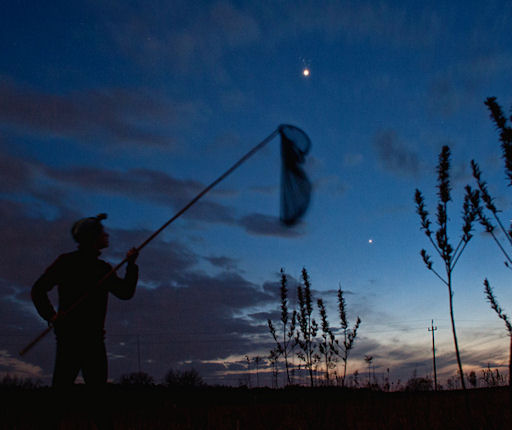INCOMING CME: A magnetic filament connected to sunspot AR1450 erupted on April 2nd, hurling a faint CME in the direction of Earth. A weak impact is expected sometime on April 4th. NOAA forecasters estimate a ~25% chance of polar geomagnetic storms when the cloud arrives. Aurora alerts: text, phone.
CATCH THE CONJUNCTION! When the sun sets tonight, go outside and look west. The planet Venus is in conjunction with the Pleiades star cluster. This only happened once every eight years, so don't miss it!
Last night in Puławy, Poland, photographer Kamila Mazurkiewicz was determined to catch the meeting:
"Venus and the Pleiades were like diamonds in the sky," says Mazurkiewicz. "It was a beautiful sight."
Although the conjunction may be seen with the unaided eye, it is even more beautiful through a small telescope, binoculars, or the lens of a camera. Regard this magnificent close-up from David A. Harvey of Tucson, Arizona. His camera settings are available for readers who wish to try a similar composition.
Connecting the dots, the brightest stars of the Pleiades resemble a tiny dipper. Tonight, April 3rd, Venus will brush the bottom of the dipper's bowl--a very close encounter indeed. Enjoy the show!
more images: from Alan Dyer of Gleichen, Alberta; from Gary A. Becker of Coopersburg, PA; from the Charlie Bates Solar Astronomy Project of Atlanta, GA; from Daniel J. Linek of Oneonta, NY; from Joe McBride of Grand Rapids, MI; from Aaron Top of Shallow Lake Ontario Canada; from Chris Pruzenski of Hemlock, NY; from John Stetson of Falmouth, Maine

![]()
Solar wind
speed: 321.4 km/sec
density: 0.5 protons/cm3
explanation | more data
Updated: Today at 1635 UT
![]()
X-ray Solar Flares
6-hr max: B4 1228 UT Apr03
24-hr: B4 0408 UT Apr03
explanation | more data
Updated: Today at: 1600 UT
![]()
![]()
![]()
Daily Sun: 03 Apr 12
![]()
![]()
Sunspot 1450 is growing and could soon post a threat for C-class flares. Otherwise, solar activity is low. Credit: SDO/HMI
![]()
![]()
![]()
Sunspot number: 67
What is the sunspot number?
Updated 02 Apr 2012
Spotless Days
Current Stretch: 0 days
2012 total: 0 days (0%)
2011 total: 2 days (<1%)
2010 total: 51 days (14%)
2009 total: 260 days (71%)
Since 2004: 821 days
Typical Solar Min: 486 days
Updated 02 Apr 2012
The Radio Sun
10.7 cm flux: 106 sfu
explanation | more data
Updated 02 Apr 2012
![]()
![]()
![]()
Current Auroral Oval:
![]()
Switch to: Europe, USA, New Zealand, Antarctica
Credit: NOAA/POES
![]()
![]()
![]()
Planetary K-index
Now: Kp= 1 quiet
24-hr max: Kp= 2 quiet
explanation | more data
![]()
Interplanetary Mag. Field
Btotal: 4.1 nT
Bz: 3.9 nT south
explanation | more data
Updated: Today at 1637 UT
![]()
![]()
![]()
Coronal Holes: 02 Apr 12
![]()
![]()
There are no large coronal holes on the Earthside of the sun. Credit: SDO/AIA.





